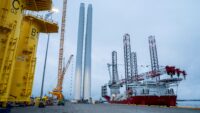Virginia Beach maritime contractor to hire 86 workers
Virginia Beach maritime government contractor Anchor Innovation plans to add 86 jobs as part of an expansion, Gov. Glenn Youngkin announced Thursday. Founded in 2002, Anchor Innovation is a service-disabled, veteran-owned contractor providing marine maintenance and support to the U.S. Navy, including vessel repairs and upgrades. Anchor Innovation plans to invest $213,000 on the expansion, [&hellip[...]
Dominion’s offshore wind vessel arrives in Hampton Roads
The United States’ first offshore wind turbine installation vessel — The Charybdis — has arrived home in Hampton Roads.
Shamin Hotels debuts first Hyatt Select in US
Shamin Hotels opens the first Hyatt Select in the U.S. in Chester and plans a new Outset Collection hotel in Virginia Beach.
Virginia Beach considers another sports venue on Oceanfront
Virginia Beach wants another major sports venue near the Oceanfront and is asking developers to pitch ideas on how to proceed.
Atlantic Park surf lagoon makes waves in Virginia Beach
Atlantic Park Surf debuts in Virginia Beach with a Wavegarden lagoon, year-round waves, a new concert venue and luxury entertainment options.
Virginia 500 October 2025 Spotlight: CHRIS KEFFER
FIRST JOB: Washing dishes at the local restaurant INTERESTING PLACES I’VE TRAVELED: The Exumas and Abacos, super cool island chains that are part of the Bahamas MOST VALUED POSSESSION: Babe Ruth autographed baseball given to me by my grandmother ADVICE FOR NEW COLLEGE GRADS: Show up early to work, take on hard projects and demonstrate […]
Trump administration withdraws $39.27M for Norfolk offshore wind project
The Trump administration withdrew $39.27 million in federal funding that had been awarded for an offshore wind logistics port in Norfolk.
Government Contractors | Technology 2025: ANGOLD, RYAN
A graduate of the U.S. Naval Academy and former Navy SEAL, Angold leads a company that was named the 24th largest federal contractor in 2019. Angold left the military in 2005 and joined Blackbird Technologies, a solutions provider for the intelligence community that’s now part of RTX. After a stint at VP Expeditionary Programs in […]
US government halts nearly complete offshore wind farm. Is Virginia’s next?
The Trump administration last week halted construction on a nearly complete wind farm off the coast of Rhode Island and Connecticut.
Luminoah wins Virginia Startup World Cup
Charlottesville-based medical technology company Luminoah won first place at the Virginia Startup World Cup.
Virginia Wesleyan University to be renamed Batten University
Next year, Virginia Wesleyan University will officially change its name to Batten University, honoring local philanthropist Jane Batten.
Atlantic Park Surf to open Saturday
Atlantic Park Surf, North America’s first Wavegarden Cove Surf Lagoon on the East Coast, is set to open to the public on Saturday.























